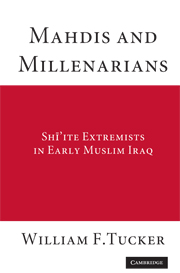Book contents
- Frontmatter
- Contents
- Acknowledgments
- Preface
- Mahdis and Millenarians
- Introduction: Historical Background – Umayyad Rule
- 1 Earlier Movements
- 2 Bayān ibn Sam‵ān and the Bayāniyya
- 3 Al-Mughīra ibn Sa‵īd and the Mughīriyya
- 4 Abū Mansūr al-‵Ijlī and the Mansūriyya
- 5 ‵Abd Allāh ibn Mu‵āwiya and the Janāhiyya
- 6 Influence and Significance of the Four Sects
- Conclusion
- Epilogue
- Bibliography
- Index
- References
Bibliography
Published online by Cambridge University Press: 04 December 2009
- Frontmatter
- Contents
- Acknowledgments
- Preface
- Mahdis and Millenarians
- Introduction: Historical Background – Umayyad Rule
- 1 Earlier Movements
- 2 Bayān ibn Sam‵ān and the Bayāniyya
- 3 Al-Mughīra ibn Sa‵īd and the Mughīriyya
- 4 Abū Mansūr al-‵Ijlī and the Mansūriyya
- 5 ‵Abd Allāh ibn Mu‵āwiya and the Janāhiyya
- 6 Influence and Significance of the Four Sects
- Conclusion
- Epilogue
- Bibliography
- Index
- References
- Type
- Chapter
- Information
- Mahdis and MillenariansShiite Extremists in Early Muslim Iraq, pp. 143 - 166Publisher: Cambridge University PressPrint publication year: 2008



